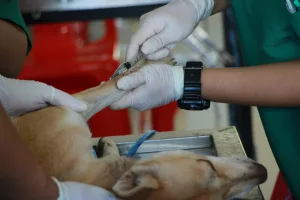Dog paws play an integral role in the lives of our four-legged companions. From chasing squirrels to accompanying us on outdoor adventures, their paws carry them through all kinds of terrain. Yet, it’s not uncommon to see dogs suffer from sensitive or painful paws. This sensitivity can limit their ability to explore and lead a fulfilling life. Understanding the factors contributing to paw sensitivity and pain can help us provide better care for our furry friends.
The Anatomy of Dog Paws
Structural Makeup
Dog paws consist of various parts that collectively provide protection, grip, and sensory information. These include:
- Paw Pads: The pads are thick cushions made up of fatty tissue and tough skin that protect the foot bones, absorb shock, and provide grip. They act much like shoes for humans, offering a layer of protection.
- Nails: Dogs have strong nails that help with traction and digging. Regular trimming is crucial as overgrown nails can cause discomfort and lead to altered gait.
- Dewclaws: Some dogs have dewclaws, extra digits resembling thumbs, which may touch the ground or be higher up on the leg. While they don’t always serve a functional purpose, they can still be prone to injury.
- Nerve Endings: Each paw contains a dense network of nerve endings, which provide sensory feedback to navigate different surfaces. This intricate system is essential for balance and detecting environmental changes.
Functionality
Paws serve multiple purposes, from protecting against harsh environments to providing balance and traction. They also contain sweat glands that help regulate body temperature. Despite being robust, dog paws are not impervious to injury or illness, and their sensitivity plays a vital role in protecting the dog from further harm.
Why Are Dog Paws So Sensitive?
Sensitivity in dog paws is a natural defense mechanism that allows dogs to respond quickly to dangerous situations. Let’s explore this further:
High Density of Nerve Endings
Dog paws are packed with nerve endings, making them highly sensitive to touch, pressure, and temperature changes. This sensitivity is crucial for dogs to detect hazardous terrain quickly, adjust their movements, and avoid injury. For instance, when a dog steps on a sharp object, its immediate reaction is to lift the paw, minimizing potential damage.
Temperature and Climate Exposure
Paws are directly exposed to the environment, often facing extreme temperatures on hot pavement or icy snow. The thin layer of skin between the pad and the ground doesn’t insulate dogs from heat or cold very well, making them vulnerable to burns and frostbite. Even moderate weather conditions can cause discomfort if prolonged exposure occurs. Imagine walking barefoot on a hot summer day; dog paws experience similar discomfort.
Rough Terrain and Foreign Objects
Walking on rough surfaces like gravel, rocks, or debris can cause abrasions and cuts. Additionally, foreign objects like thorns or glass can get embedded in the paw pads, leading to immediate sensitivity or infection if left untreated. A simple walk in the park can turn painful if a small piece of glass goes unnoticed.
Common Causes of Painful Dog Paws
Understanding the root causes of paw pain is essential for effective treatment and prevention.
Injuries
- Cuts and Abrasions: Sharp objects or rough terrain can lead to painful cuts and scrapes on the pads. Always inspect your dog’s paws after outdoor activities, especially in unfamiliar areas.
- Burns and Frostbite: Extreme temperatures can damage the sensitive skin of the paw pads, causing burns or frostbite. In winter, road salt can also irritate and dry out paw pads.
- Nail Injuries: Broken or overgrown nails can dig into the paw or cause the dog to walk awkwardly, leading to pain. Regular nail care is vital to prevent such issues.
Infections and Allergies
- Bacterial/Fungal Infections: Moisture trapped in the paw can lead to infections, making them red, swollen, and painful. Ensure paws are dried thoroughly after exposure to water.
- Allergies: Dogs may react to chemicals, plants, or foods, causing itchy, inflamed paws. Observe your dog’s reaction to new environments or foods to identify potential allergens.
Health Conditions
- Arthritis: Joint inflammation can cause a dog to walk differently, leading to secondary pain in their paws. Supporting joint health with proper diet and supplements can help manage symptoms.
- Autoimmune Diseases: Some conditions, like pemphigus, can affect the paw pads directly, leading to cracking, pain, and sensitivity. Regular vet check-ups can help catch these conditions early.
Behavior
- Excessive Licking: Dogs sometimes lick their paws excessively due to anxiety, stress, or boredom. This behavior can irritate the skin, causing raw, painful areas. Behavioral training and providing engaging toys can help mitigate this habit.
Caring for Sensitive or Painful Dog Paws
Proactive care can prevent many paw issues and keep your dog comfortable.
Regular Inspections and Cleaning
Check your dog’s paws frequently, especially after walks or outdoor play, to identify any cuts, foreign objects, or irritation. Wash with gentle pet shampoo to remove dirt and allergens. A quick wipe down with a damp cloth can also help keep paws clean on a daily basis.
Nail Maintenance
Trim your dog’s nails regularly to prevent overgrowth and injuries. If unsure, consult a veterinarian or groomer to avoid cutting too short. A good rule of thumb is that you should be able to insert a piece of paper between the nail and the floor when the dog is standing.
Moisturization
Apply pet-safe balms or moisturizers to keep the paw pads hydrated and prevent cracking. Avoid human moisturizers, as some ingredients can be harmful to dogs. Products containing natural oils like coconut or shea butter are typically safe and effective.
Seasonal Protection
- Winter: Use booties to protect against ice and salt, or clean and dry the paws thoroughly after walks. A thin layer of petroleum jelly can also provide a barrier against harsh elements.
- Summer: Test the pavement with your hand to ensure it’s not too hot, and stick to shaded paths when possible. Walking during cooler parts of the day can also help prevent burns.
Vet Consultation
If your dog shows persistent signs of paw pain, such as limping or excessive licking, consult a veterinarian for a proper diagnosis and treatment plan. Early intervention can prevent minor issues from becoming serious problems.
Additional Tips for Paw Care
DIY Solutions for Minor Issues
- Oatmeal Soak: For irritated paws, an oatmeal soak can provide relief. Simply grind plain oatmeal into a fine powder and mix it with warm water to create a soothing soak.
- Aloe Vera Gel: Applying pure aloe vera gel can soothe burns and promote healing. Ensure the aloe is free from additives and safe for pets.
Training for Paw Handling
Getting your dog comfortable with having their paws handled can make grooming and inspections easier. Start by gently touching and holding their paws, rewarding them with treats and praise. This positive reinforcement helps them associate paw handling with a pleasant experience.
Recognizing Signs of Distress
Pay attention to your dog’s behavior. Limping, reluctance to walk, or excessive licking may indicate discomfort. Addressing these signs promptly with appropriate care or veterinary advice can prevent further complications.
Case Study: Max’s Journey to Healthy Paws
Consider the story of Max, a lively Labrador retriever who loved his daily walks. His owner noticed he started limping after their usual route. Upon closer inspection, small cuts from sharp gravel were found on his paws. With regular cleaning, application of a pet-safe balm, and temporary use of protective booties, Max’s paws healed quickly, allowing him to enjoy his walks once again. This highlights the importance of regular inspections and immediate care.
Common Mistakes in Paw Care
- Ignoring Small Issues: Minor cuts or abrasions can easily be overlooked but may lead to infections if untreated.
- Using Inappropriate Products: Human lotions or ointments can be toxic to dogs. Always opt for products specifically made for pets.
- Neglecting Regular Checks: Skipping routine checks can mean missing early signs of problems. Make paw inspections a part of your grooming routine.
- Inconsistent Nail Trimming: Overgrown nails can be painful. Maintain a regular schedule to keep nails at a comfortable length.
By taking these steps, you ensure that your dog’s paws remain healthy and pain-free, providing them with the comfort and mobility they need to thrive. Our canine companions rely on us to care for their well-being, and with attentive care, we can help them lead happy, active lives.




